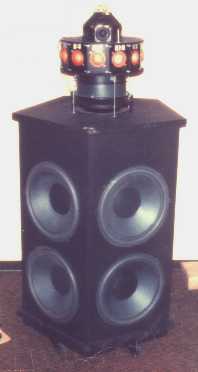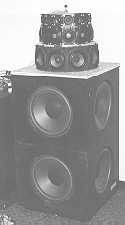McIntosh Polygon Systems
Copyright 1996-2003 by Roger Russell
All rights reserved
No portion of this site may be reproduced in whole or in part
without written permission of the author.
 In 1974 I design a
unique system having omnidirectional characteristics. One of the features of
this multiple driver system is the high power handling at higher frequencies.
The first design is in the shape of a pentagon. It consists of the drivers from
the ML-1C system. There are four 12" woofers on two adjacent faces. There
are two 8" mids. One is mounted facing upwards with a small enclosure
behind it. The second one faces downward into the first one and it has a small
enclosure behind it. Above this is a circle of 016 1-1/2" upper midrange
domes. Above that is a cluster of 2-1/4" tweeters. They are formed in a
circle plus four are angled upwards at an angle of 45 degrees. A switch in the
center of the tweeter cluster changes the radiation pattern.
In 1974 I design a
unique system having omnidirectional characteristics. One of the features of
this multiple driver system is the high power handling at higher frequencies.
The first design is in the shape of a pentagon. It consists of the drivers from
the ML-1C system. There are four 12" woofers on two adjacent faces. There
are two 8" mids. One is mounted facing upwards with a small enclosure
behind it. The second one faces downward into the first one and it has a small
enclosure behind it. Above this is a circle of 016 1-1/2" upper midrange
domes. Above that is a cluster of 2-1/4" tweeters. They are formed in a
circle plus four are angled upwards at an angle of 45 degrees. A switch in the
center of the tweeter cluster changes the radiation pattern.
Although this started out as a commercial disco system, it can also be
used in the home as well. The 360-degree radiation pattern, however, makes
placement against a wall or in a corner undesirable due to the resulting
reflections, uneven response and smeared imaging. When placed out in the room
well away from reflecting surfaces, the system works very well.
To be more compatible with home requirements, I add a switch for the
domes and tweeters. This connects all of them for the omni position, front and
back drivers for the figure eight position and front only drivers for the front
position. The omni and front positions connect all the drivers in phase. In the
figure eight position, the rear facing speakers are connected out of phase for
operation similar to an open back dipole speaker. Horacio Moreno, an associate
engineer that I hired, assembles the systems and develops the crossover
networks for them.
A four, two and single woofer system is planned using the pentagon shape.
The woofers are on two adjacent faces except for the single woofer system that
is on a flat recessed panel across two faces. An open top framework and grille
is made to house the top section for use in the home. Warren & Friedman are
again hired to design the appearance of the systems. Although the systems work
very well, the complex construction of the cabinets make the cost relatively
high.
 A second square
version is constructed using more recent drivers from the XR5 system. It
consists of a square four woofer bass cabinet and a top section having a
circles of nine 5" lower-mids, twelve 1-1/2" 035 upper-mids and
sixteen 2-1/4" tweeters. The top section can be installed separately
upside down at the ceiling for use in a disco. The bass section can be located
on the floor.
A second square
version is constructed using more recent drivers from the XR5 system. It
consists of a square four woofer bass cabinet and a top section having a
circles of nine 5" lower-mids, twelve 1-1/2" 035 upper-mids and
sixteen 2-1/4" tweeters. The top section can be installed separately
upside down at the ceiling for use in a disco. The bass section can be located
on the floor.
The switch at the top now affects the lower mids as well as the upper
mids and tweeters and is more effective in controlling the directional pattern.
Power level and fuse lights are located in the bass cabinet.
New information indicates that the demand for disco use is insufficient.
The costs, with the large number of drivers and relatively high priced
cabinets, for home use is too high at this time to make a production product.
The projects are cancelled.
Looking back at the first system, it reminds me of the robot in a 1954
grade B science fiction movie called GOG. It's very similar except it has no
arms. Oddly enough there is a second robot in the movie called MAGOG. Of course
two are needed for stereo! Not only that but the movie was originally made in
3-D!
![]()
|
About This Site |
||
|
|
More text and pictures about McIntosh will be added as my research continues. Any comments, corrections, or additions are welcome. |
|
|
|
Created by Roger Russell |
|